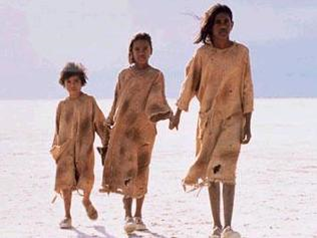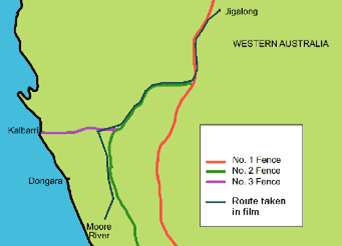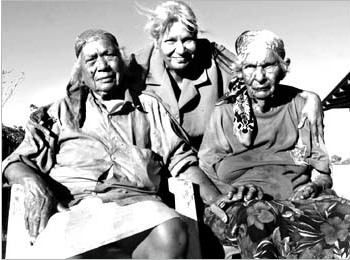 Miramax Films (2002)
Miramax Films (2002)
The Rabbit Proof Fence
The United States is not the only country to mistreat its native population. A history of colonization typically results in the subjugation of the conquered peoples. In Australia, the aboriginal population suffered the tragedy of the Stolen Generations. The Stolen Generations refer to the aboriginal and mixed race children who were forcibly taken from their homes and families by the Australian government and placed in boarding schools and internment camps. These removals started in 1909 and continued until the 1970s. Between one in three and one in ten Indigenous children were forcibly removed from their families during this time and many of them suffered from abuse while in government custody. Many were permanently separated from their families, unable to ever reconnect with their parents or siblings. This breaking up of families had far-reaching social and psychological consequences on the aboriginal population.
In 2000, Phillip Knightley summed up the Stolen Generations in these terms:
“This cannot be over-emphasized—the Australian government literally kidnapped these children from their parents as a matter of policy. White welfare officers, often supported by police, would descend on Aboriginal camps, round up all the children, separate the ones with light-colored skin, bundle them into trucks and take them away. If their parents protested they were held at bay by police.”
 Wikipedia
Wikipedia
The Fence
Rabbits are actually a huge pest problem in Australia. They were introduced into the ecosystem in the 1850s by European settlers and they spread rapidly throughout the continent, decimating crops and have led to the extinction of many native plant species. The rabbit-proof fence was built between 1901 and 1907 in an attempt to contain the pests and stretches over 2,000 miles across the country. The map to the left shows the fence and the route the girls took to find their way home.
Film Synopsis
Rabbit-Proof Fence is a 2002 Australian film about the true story of three girls who were victims of the forced resettlement and walked across the country to reunite with their families. It begins in Western Australia in 1931, in the remote town of Jigalong. Two sisters, 14 year-old Molly and 8 year-old Daisy, live with their mother, grandmother, and their 10 year-old cousin Gracie. The girls are “half-castes”, meaning that they have one white parent and one Aboriginal parent. The Chief Protector of Aborigines, A.O. Neville, orders that the three girls be taken from their families and taken to his re-education camps. His goal is to “breed” out the aboriginal blood from half-caste children. He plans for the girls to be educated in the camps and to be brought up to become servants to white families—what he regards as a “good” situation for such children. He hopes that they will marry white Europeans and so the Aboriginal “blood” will eventually diminish and the culture will disappear. A local constable, Riggs, arrives in Jigalong and drags away the three girls from their family and sends them to camp at the Moore River Native Settlement in the south.
Molly, Daisy, and Gracie escape from the camp and plan on following the Rabbit-proof fence back to the hometown of Jigalong. It is an epic 1,500 mile journey through the harsh Australian outback that they make on foot. An Aboriginal tracker, Moodoo, is called in by Neville to track down the girls and bring them back to the camp. The girls are well trained in hiding their tracks and, with some help from strangers on the way, they manage to evade Moodoo and Riggs several times.
In an attempt to trap the girls, Neville spreads the word among the Aboriginal community that Gracie’s mother is waiting for her in the town of Wiluna. It is, of course, a lie but the information finds its way to an Aboriginal traveler who tells the news to Gracie. Suspecting that it’s actually a trap, Molly and Daisy try to dissuade Gracie from going to the Wiluna train station to meet her mother. But Gracie is desperate to reunite with her mother and leaves her cousin to go meet her in Wiluna. Molly and Daisy follow Gracie and watch her from afar as she waits at the station for her mother. The girls watch as Gracie is ambushed by Riggs and dragged away to return to the camp. Unable to do anything to help their cousin, Molly and Daisy continue on their journey back home to Jigalong. The girls eventually make it back home, reuniting with their mother and grandmother. The four of them go into hiding in the desert in order to avoid recapture. Neville eventually realizes that he can no longer afford to search for the girls and so calls off their pursuit.
The Epilogue
 Molly Kelly, right, with her daughter Doris Pilkington center, and
Molly Kelly, right, with her daughter Doris Pilkington center, and
sister Daisy Kadibil, who endured the long trek along the fence with her.
Photo: Dione Davidson
The film’s epilogue shows footage of the real Molly and Daisy, both now old women. Gracie has died and never did return to Jigalong. Molly also tells us of her own two daughters: she and they were taken from Jigalong back to the Moore River Settlement. She managed to escape with one daughter, Annabelle, and once again, she walked the length of the fence back home. However, when Annabelle was 3 years old, she was taken away once more, and Molly never saw her again. In closing, Molly says that she and Daisy “… are never going back to that place”.
“This is a true story – story of my sister Daisy, my cousin Gracie and me when we were little. Our people, the Jigalong mob, we were desert people then, walking all over our land. My mum told me about how the white people came to our country. They made a storehouse here at Jigalong – brought clothes and other things – flour, tobacco, tea. Gave them to us on ration day. We came there, made a camp nearby. They were building a long fence. “
Bibliography
“For Molly, the fence was a lifeline.” Obituaries. The Sydney Morning Herald. 2004. Web. 1 Apr. 2015.
Knightely, Philip. “Longtime Australian Policy: Kidnapping Children From Families.” The Center for Public Integrity. 8 Feb. 2001. Web. 1 Apr. 2015.
Rabbit-Proof Fence. Dir. Phillip Noyce. Perf. Everlyn Sampi, Tianna Sansbury, Laura Monaghan, and Kenneth Branagh. Miramax, 2002. Film.
“The Rabbit-Proof Fence.” Western Perspectives on a Nation. State Library of Western Australia, n.d. Web. 1 Apr. 2015.
